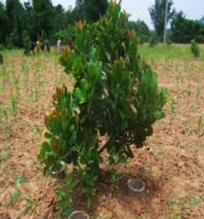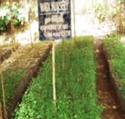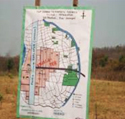 |
Nabard Tribal
Wadi Project |
|
The central focus of the ADPs is “wadi” (small orchard) together with suitable soil conservation, water resource development measures and other measures for improving the quality of tribal life such as community health & sanitation, women development, institutional development, etc. The wadi model has been acclaimed worldwide as a sustainable and replicable model for poverty alleviation. The project was presented as a successful replicable model for poverty alleviation in the developing countries at the UNDP Forum of Ministers for Poverty and Environment in New York, USA in 1999 as well as at the Global Dialogue in Hanover, Germany. This project was also exhibited in the “Basic Needs Pavilion” at the Expo-2000, GmbH, Hanover.
A brief overview of the wadi model and the two programmes is provided at the following links
Wadi model
Adivasi Development Programmes
Tribal Development Fund – an ambitious initiative from NABARD
Based on the successful experience of Adivasi Development Programmes, NABARD embarked upon an ambitious program of replicating the wadi model across the country. In this direction, NABARD created a Tribal Development Fund (TDF) with a corpus of Rs. 50 crore, out of its profits for 2003-04. The corpus has now grown to Rs. 575 crore. All projects under TDF are implemented by partnering with State Governments, Government of India, NGOs and Corporates,
- Project design
- Status of implementation
- Positive features in implementation strategy
- Good project interventions
Purpose of TDF
- To promote sustainable participatory livelihood programmes (“Wadi” model and “beyond Wadi approaches”) which inter alia, aim at economic uplift through sustainable agriculture, social empowerment, improvement in quality of life including health and women development, in tribal predominant areas of the country through demonstration projects supported through Non Government Organisations (NGOs)/ Community Based Organisations (CBOs) / GOs. The “Beyond Wadi approaches may include (a) livelihoods based on traditional arts and crafts or agro and forest based activities for illiterate or semi-literate groups, (b) projects harnessing the core competencies of the potential tribes, viz., organic cultivation; indigenous knowledge especially regarding medicinal plants and preparation of medicines; collection, extraction and usage of natural dyes; etc.
- To take up promotional efforts such as capacity building, exposure visits, training,developing literature, sensitization programmes etc. for the benefit of communities, NGOs, SHGs, Panchayats, Bankers and Government Departments.
- To implement sustainable livelihood programmes and similar other relevant initiatives through the state governments.
- To support promotional activities for micro-credit, promotion of SHGs, Income Generating Activities for land-less, SC / ST communities and other weaker sections of the community and other related activities in conjunction with the livelihood development programme.
- To support activities related to development of tribal market, processing and marketing of products manufactured by tribal families/ communities.
- To support other relevant activities as approved by NABARD.
Project design
The TDF projects aim to provide sustainable livelihoods to tribal families through orchard based farming systems. The characteristic features of TDF projects are
farming systems. The characteristic features of TDF projects are
- Shift in focus from farmer centric to family centric
- Project size of 500 to 1000 families covering approximately 500 - 1000 acre of orchard plantation in a 2-3 clusters
- Support for one acre per family
- Project duration of 5-7 years.
- The project funding is done on grant/ loan basis or blend of both as found appropriate. Generally, the project cost is met as a grant and it is ensured that the participants contribute at least 25% of the labour component. To inculcate good credit habits among the participants, a small loan component (around 10% of the project cost) is provided as loan to Project Implementing Agency (PIA) for on lending. The loan period and interest rate for on lending to the project participants would be decided at the time of sanction of the project.
 Orchard cultivation as the core component and complementary measures such as soil conservation, water resource development, inter crop, fencing and boundary plantations (forestry species). While the fruit plants generate income after 4-5 years, the forestry species provide a fence and also act as a shelter belt. Orchard cultivation as the core component and complementary measures such as soil conservation, water resource development, inter crop, fencing and boundary plantations (forestry species). While the fruit plants generate income after 4-5 years, the forestry species provide a fence and also act as a shelter belt.
The species mix planted meets the families’ needs for fuel, fodder and small timbers. It also helps in reducing the pressure on existing forests. A one acre orchard accommodates around 60 fruit plants (depending on spacing) and 600-800 forestry plants and provides adequate income and livelihood security under climatic vagaries. In five years, a poor village of 100 families gets converted into an orchard of a 100-150 acre producing hundreds of tonnes of fruits.
- Human resource development (community development) and promotion of community based organizations.
- Women development - A special emphasis is given for involvement of women in all spheres of the programme. The components include drudgery reduction measures, on-farm and non-farm income generating activities and self help groups for inculcating thrift and credit habits.
- Community health and sanitation
- Special strategies for promotion of micro-enterprises for land less people
- Processing & marketing
- Training and capacity building is a very crucial aspect of implementation of TDF projects given the wide variety of activities undertaken and host of processes involved. At the national level, BAIF is providing the resource support services. Series of capacity building programs are held at Dhruva for NABARD officers, Senior State Government officials, the project implementing agencies and farmers. BAIF also undertakes facilitation visits to project sites across the country for providing inputs on technical aspects and operational issues.
- Other auxillary components to dovetail with above activities.
Status of implementation of TDF projects
As many as 136 projects have been sanctioned in 22 States, viz., Rajasthan (22), Chattisgarh (16), Andhra Pradesh (20), Orissa (19), Madhya Pradesh (11), West Bengal (8), Karnataka (6), Assam (3), Bihar (6), Meghalaya (3), Gujarat (3), Mizoram (2), Maharashtra (2), Nagaland (2), Jharkhand (2), Uttar Pradesh (3) and 1 project each in Manipur, Arunachal Pradesh, Uttarakhand and Union Territory of Dadra and Nagar Haveli. The projects are targeted to benefit 1.13 lakh tribal families and are being implemented by 90 NGOs. involving a total TDF assistance of Rs 380.57 crore of which the grant support is Rs. 356.58 and loan is 23.99 crore. These projects would directly benefit about 1.13 lakh tribal families from those states/ UT. The state wise and district wise number of projects is indicated in annexure I and II
Some positive policy developments
- Collaboration with State Govt (West Bengal), Corporates (Chattisgarh. AP,)
- First time projects in Tamilnadu and Andaman & Nicobar islands
- Diversification into other livelihoods such as non farm sector, minor forest produce, etc
- State level resource support organisations
- Decentralization of project sanction to Regional Offices
- Grant support per family upto 40000/-
- Support for families owning less than one acre supplemented by other income generating activities.
- Support to non tribals inhabiting the project area to the extent of 10% of the targeted project families
Good interventions under NABARD TDF projects
Chattisgarh
- Unique identification number for project beneficiaries
- Balwadis for children of working tribals and upscaling the idea to mid day meal and basic education
- Adult education
- Wadi plantation and vegetable cultivation in schools
- Bathrooms for tribal women
- Vegetables as intercrops
Orissa
- Community sprayers from farmer wages
- Convergence with govt depts
- Low cost water purifiers
- Low cost water lifting devices
- Routing the payments to Uddhaan vikas committee (village level comm)
- Federating the UVS
- Technical collaboration with reputed institutes
- Identification of project specific nodal officers at the RO
- Livelihood plans for land less
- Use of bio pesticides
Andhra Pradesh
- Art and culture, community halls as entry point activities
- Vegetables as inter crops and sale outlets in the nearby towns, brand name and labelling
- Low cost irrigation structures
- Maa thota committees – thrift (one year - > 2 lakhs)
- Payments routed through Maa Thota Committees
- Facilitation of bank finance for NFS activities
- Collaboration with Govt departments
- Exposure visits sponsored by Hort dept
- Onsite training by Hort department
- Vegetable seed kits from hort/agri depts
- Energisation of pumpsets by tribal dept
- Jungle clearance and land levelling by tribal dept
- Bore wells by tribal dept
- Publicity measures
- Documentation - project annual reports
What is “Wadi” ?
The “Wadi” model of tribal development is holistic in approach addressing production, processing and marketing of the produce and also other needs. The core of the programme is “Wadi” and other development interventions are built around “Wadi”. The “Wadi”' in Gujarati means a 'small orchard' covering one or two acres. The ‘‘Wadi’’ as an effective tool for tribal development evolved gradually out of two decades of concerted efforts made by BAIF in Vansda (Gujarat). The “Wadi” may be of mango or cashew or amla or any fruit crop suitable to the area or a combination of these tree crops, with forestry species on the periphery of the land holdings. Two or more tree crops are selected in the ‘‘Wadi’’ model to minimize the climatic, biological and marketing risks. Tribal families having less than 5 acre land is given 1 acre wadi each for raising 60 fruit plants suitable to local area and 600 forestry plants on the boundary.
Other development interventions in the areas of environment, gender and health viz., soil conservation in the wadis, water resource development, agriculture development, women development, health are woven around the wadi.
Water resources development: Even though the programme area receives an annual rainfall of 2500 mm, because of steep slopes and rocky terrain, water retention is poor resulting in severe soil erosion and nutrient loss. As existing water resources are not sufficient to irrigate ‘‘Wadi’’ plots, run off water is harvested through construction of temporary check bunds across river streams and development ofperennial springs. The spring water is used for drinking as well as irrigation purposes. Pot drip irrigation is provided for the fruit plants in the initial 3 years of plantation as protective irrigation.
Soil conservation measures viz., bunding, tree platforms, the combination of these two and trench-cum-bund based on field level requirements have been introduced from the first year. The participants are paid for the soil conservation and plantation work done by them in their fields.
Health Programme : Some of the basic problems faced by the tribal families are related to malnutrition, illness and inaccessibility to health care. Community health programme focuses on mother and child health care (MCH) as well as primary and preventive health care. The participants are educated on sanitation and hygiene. The local youth, especially women, called Village Health Guides (VHG) are trained in diagnosis and treatment of common illness and serious cases are referred to appropriate facilities.
Women Development: There has been an increased emphasis on women’s participation in the programme. The major activities taken up are promotion of SHGs, income generation activities, drudgery reduction along with awareness generation about reproductive health and development aspects.
The income generating activities included fruit and forest plant nurseries, vegetable cultivation, produce collection, papad making, vermi composting etc. In order to reduce drudgery of women, three major activities are taken up in the field. They are smokeless stoves, use of bearings in the traditional grinding stones and pedal thresher for paddy.
Support to Landless:Besides the land holding families, the programme has supported landless by providing micro-enterprises in farm and non-farm sectors and employment opportunities in processing units.
Processing and Marketing:
The programme has been designed to ensure assured market and remunerative prices for the wadi related produce. Decentralised processing facilities for cashew and mango are established under the cooperative fold with two levels viz., village and cooperative (central). This has facilitated creation of employment opportunities for landless tribal families in the project area and also ensured appropriate price for the farm produce, by providing captive market for the raw material and better returns through value addition.
|
 Orchard cultivation as the core component and complementary measures such as soil conservation, water resource development, inter crop, fencing and boundary plantations (forestry species). While the fruit plants generate income after 4-5 years, the forestry species provide a fence and also act as a shelter belt.
Orchard cultivation as the core component and complementary measures such as soil conservation, water resource development, inter crop, fencing and boundary plantations (forestry species). While the fruit plants generate income after 4-5 years, the forestry species provide a fence and also act as a shelter belt. 
